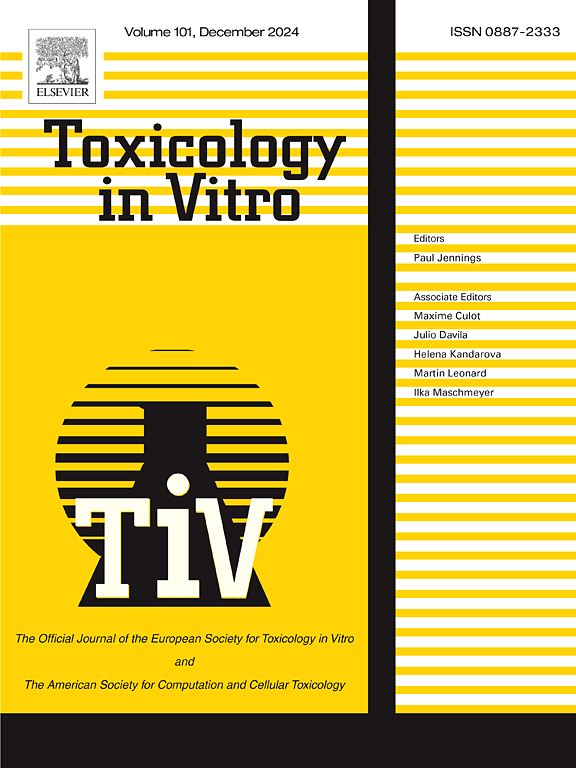Conditioned medium of human umbilical cord-mesenchymal stem cells cultivated with human cord blood serum enhances stem cell stemness and secretome profiles
IF 2.6
3区 医学
Q3 TOXICOLOGY
引用次数: 0
Abstract
The proteins secreted by human umbilical cord mesenchymal stem cells (hUC-MSCs) may enhance tissue regeneration and wound healing. Traditional hUC-MSC cultures may not be enough since they undergo recurrent cellular senescence during large-scale production. This decreases the therapeutic ability of hUC-MSCs by altering genes and proteins that control stemness, proliferation, and protein release. Human cord blood serum (CBS) and the middle-density technique were used to evaluate hUC-MSC regeneration ability. To evaluate early-passage hMSCs for secretome-based therapies, they were expanded and secreted in vitro. After 4 days, hUC-MSCs cultivated at 3000 cells/cm2 and supplemented with 1 ng/ml CBS showed increased growth, cell proliferation, and a much lower population doubling time. CBS treatment reduced CD34, CD45, and HLA-DR levels in human umbilical cord mesenchymal stem cells (hUC-MSCs) by less than 2 %. Positive markers such CD73, CD90, and CD105 were found at >97 %, like control hUC-MSCs. Over extended culture, this combination culture can increase survival, proliferation, and stemness and postpone cell death and hUC-MSC senescence. The protein profile and hUC-MSC secretion were improved to make MSC secretion protein therapeutic. This improves cell-free treatment, proliferation, and wound healing in human skin cells. To improve cell-based transplantation or cosmeceutical manufacturing, this technique can boost hUC-MSC regeneration capacity.
用人脐带血血清培养人脐带间充质干细胞的条件培养基可增强干细胞的干性和分泌组特征。
人脐带间充质干细胞(hUC-MSCs)分泌的蛋白质可促进组织再生和伤口愈合。传统的 hUC 间充质干细胞培养可能还不够,因为它们在大规模生产过程中会反复发生细胞衰老。这会改变控制干性、增殖和蛋白质释放的基因和蛋白质,从而降低 hUC-MSCs 的治疗能力。我们采用人脐带血血清(CBS)和中间密度技术来评估hUC-间充质干细胞的再生能力。为了评估基于分泌物疗法的早期hMSCs,对它们进行了体外扩增和分泌。4 天后,以 3000 cells/cm2 培养并补充 1 ng/ml CBS 的 hUC-间充质干细胞显示出生长速度加快、细胞增殖和更低的群体倍增时间。经 CBS 处理后,人脐带间充质干细胞(hUC-MSCs)的 CD34、CD45 和 HLA-DR 水平降低了不到 2%。与对照组一样,CD73、CD90 和 CD105 等阳性标记物的含量大于 97%。经过长期培养,这种组合培养能提高细胞的存活率、增殖率和干性,推迟细胞死亡和 hUC-MSC 的衰老。蛋白质谱和 hUC-MSC 分泌得到改善,使间叶干细胞分泌蛋白具有治疗作用。这改善了无细胞治疗、增殖和人类皮肤细胞的伤口愈合。为了改善细胞移植或药用化妆品的生产,这项技术可以提高干细胞的再生能力。
本文章由计算机程序翻译,如有差异,请以英文原文为准。
求助全文
约1分钟内获得全文
求助全文
来源期刊

Toxicology in Vitro
医学-毒理学
CiteScore
6.50
自引率
3.10%
发文量
181
审稿时长
65 days
期刊介绍:
Toxicology in Vitro publishes original research papers and reviews on the application and use of in vitro systems for assessing or predicting the toxic effects of chemicals and elucidating their mechanisms of action. These in vitro techniques include utilizing cell or tissue cultures, isolated cells, tissue slices, subcellular fractions, transgenic cell cultures, and cells from transgenic organisms, as well as in silico modelling. The Journal will focus on investigations that involve the development and validation of new in vitro methods, e.g. for prediction of toxic effects based on traditional and in silico modelling; on the use of methods in high-throughput toxicology and pharmacology; elucidation of mechanisms of toxic action; the application of genomics, transcriptomics and proteomics in toxicology, as well as on comparative studies that characterise the relationship between in vitro and in vivo findings. The Journal strongly encourages the submission of manuscripts that focus on the development of in vitro methods, their practical applications and regulatory use (e.g. in the areas of food components cosmetics, pharmaceuticals, pesticides, and industrial chemicals). Toxicology in Vitro discourages papers that record reporting on toxicological effects from materials, such as plant extracts or herbal medicines, that have not been chemically characterized.
 求助内容:
求助内容: 应助结果提醒方式:
应助结果提醒方式:


